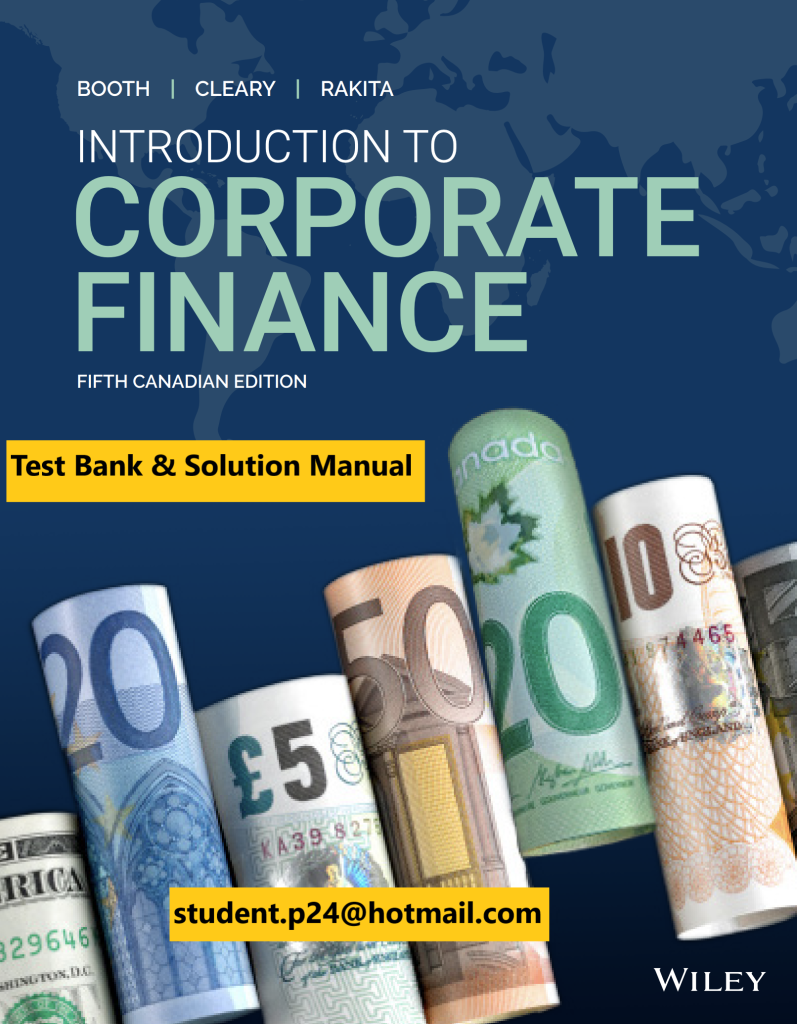TABLE OF CONTENTS
Part 1 The Financial Environment
1 An Introduction to Finance 1-1
1.1 Finance Defined 1-1
1.2 Real versus Financial Assets 1-2
1.3 The Financial System 1-6
1.4 Financial Instruments and Markets 1-14
1.5 The Global Financial Community 1-18
Summary 1-20
2 Business (Corporate) Finance 2-1
2.1 Types of Business Organizations 2-1
2.2 The Goals of the Corporation 2-6
2.3 The Role of Management and Agency Issues 2-8
2.4 Aligning Managers’ and Owners’ Interest 2-10
2.5 Corporate Finance 2-15
2.6 Finance Careers and the Organization of the Summary 2-19
Part 2 Financial Analysis Tools
3 Financial Statements 3-1
3.1 Accounting Principles 3-1
3.2 Organizing a Firm’s Transactions 3-6
3.3 Preparing Accounting Statements 3-10
3.4 Canadian Pacific Accounting Statements 3-17
Summary 3-32
4 Financial Statement Analysis and Forecasting 4-1
4.1 Consistent Financial Analysis 4-1
4.2 A Framework for Financial Analysis 4-2
4.3 Leverage Ratios 4-6
4.4 Efficiency Ratios 4-9
4.5 Productivity Ratios 4-12
4.6 Liquidity Ratios 4-14
4.7 Valuation Ratios 4-17
4.8 Financial Forecasting 4-20
4.9 Formula Forecasting 4-27
4.10 CP’s External Financing Requirements 4-30
Summary 4-33
Part 3 Valuation Basics
5 Time Value of Money 5-1
5.1 Opportunity Cost 5-1
5.2 Simple Interest 5-2
5.3 Compound Interest 5-4
5.4 Annuities and Perpetuities 5-12
5.5 Growing Perpetuities and Annuities 5-19
5.6 Quoted versus Effective Rates 5-20
5.7 Loan or Mortgage Arrangements 5-24
5.8 Comprehensive Examples 5-29
6 Bond Valuation and Interest Rates 6-1
6.1 The Basic Structure of Bonds 6-2
6.2 Bond Valuation 6-4
6.3 Bond Yields 6-14
6.4 Interest Rate Determinants 6-17
6.5 Other Types of Bonds/Debt Instruments 6-26
Summary 6-33
7 Equity Valuation 7-1
7.1 Equity Securities 7-1
7.2 Preferred Share Valuation 7-3
7.3 Common Share Valuation: The Dividend Discount Model (DDM) 7-5
7.4 Using Multiples to Value Shares 7-16
7.5 A Simple Valuation Example 7-20
Summary 7-28
Part 4 Portfolio and Capital Market Theory
8 Risk, Return, and Portfolio Theory 8-1
8.1 Measuring Returns 8-1
8.2 Types of Average Returns 8-5
8.3 Measuring Risk 8-8
8.4 Expected Return and Risk for Portfolios 8-12
8.5 The Efficient Frontier 8-22
8.6 Diversification 8-25
Summary 8-34
9 The Capital Asset Pricing Model (CAPM) 9-1
9.1 The New Efficient Frontier 9-1
9.2 The Capital Asset Pricing Model (CAPM) 9-8
9.3 The CAPM and Market Risk 9-12
9.4 Alternative Asset Pricing Models 9-20
Summary 9-24
10 Market Efficiency 10-1
10.1 Defining Market Efficiency 10-1
10.2 The Efficient Market Hypothesis (EMH) 10-5
10.3 Empirical Evidence Regarding Market Efficiency 10-6
10.4 Behavioural Finance 10-16
10.5 Implications of Market Efficiency 10-22
Summary 10-24
Part 5 Derivative Securities
11 Forwards, Futures, and Swaps 11-1
11.1 Forward Contracts 11-1
11.2 Futures Contracts 11-10
11.3 Swaps 11-18
11.4 The Financial Crisis and the Credit Default Swap Market 11-24
Summary 11-31
12 Options 12-1
12.1 Call Options 12-1
12.2 Put Options 12-9
12.3 Put-Call Parity 12-12
12.4 The Black-Scholes Option Pricing Model 12-20
12.5 Options Markets 12-24
Summary 12-30
Part 6 Long-Term Investment Decisions
13 Capital Budgeting, Risk Considerations, and Other Special Issues 13-1
13.1 Capital Expenditures 13-1
13.2 Evaluating Investment Alternatives 13-6
13.3 Independent and Interdependent Projects 13-17
13.4 Capital Rationing 13-21
13.5 International Considerations 13-24
Summary 13-28
14 Cash Flow Estimation and Capital Budgeting Decisions 14-1
14.1 General Guidelines for Capital Expenditure Analysis 14-1
14.2 Estimating and Discounting Cash Flows 14-3
14.3 Replacement Decisions 14-17
14.4 Sensitivity to Inputs 14-19
14.5 Inflation and Capital Budgeting Decisions 14-24
Summary 14-27
15 Mergers and Acquisitions 15-1
15.1 Types of Takeovers 15-1
15.2 Securities Legislation and Takeovers 15-4
15.3 Friendly versus Hostile Takeovers 15-7
15.4 Motivations for Mergers and Acquisitions 15-12
15.5 Valuation Issues 15-20
15.6 Accounting for Acquisitions 15-32
Summary 15-34
16 Leasing 16-1
16.1 Leasing Arrangements 16-1
16.2 Accounting for Leases 16-5
16.3 Evaluating the Lease Decision 16-12
16.4 Motivation for Leasing 16-15
Summary 16-16
Part 7 Long-Term Financing
17 Investment Banking and Securities Law 17-1
17.1 Conflicts Between Issuers and Investors 17-2
17.2 Securities Legislation—Basic Responsibilities 17-9
17.3 Security Offerings 17-11
17.4 IPOs and Investment Banking 17-15
17.5 Post-IPO Regulation and Seasoned Offerings 17-22
Summary 17-25
18 Debt Instruments 18-1
18.1 What is Debt? 18-1
18.2 Short-Term Debt and the Money Market 18-4
18.3 Bank Financing 18-10
18.4 Long-Term Debt and the Money Market 18-13
18.5 Bond Ratings 18-16
Summary 18-23
19 Equity and Hybrid Instruments 19-1
19.1 Shareholder Rights 19-2
19.2 Different Classes of Shares 19-5
19.3 Preferred Shares 19-10
19.4 Warrants and Convertible Securities 19-14
19.5 Other Hybrids 19-21
Summary 19-27
20 Cost of Capital 20-1
20.1 Financing Sources 20-2
20.2 The Cost of Capital 20-7
20.3 Estimating the Non-Equity Component Costs 20-11
20.4 The Effects of Operating and Financial Leverage 20-16
20.5 Growth Models and the Cost of Common Equity 20-18
20.6 Risk-Based Models and the Cost of Common Equity 20-28
20.7 The Cost of Capital and Investment 20-35
Summary 20-37
Part 8 Financial Policies
21 Capital Structure Decisions 21-1
21.1 Financial Leverage 21-1
21.2 Determining Capital Structure 21-10
21.3 The Modigliani and Miller (M&M) Irrelevance Theorem 21-14
21.4 The Impact of Taxes on Capital Structure 21-20
21.5 Financial Distress, Bankruptcy, and Agency Costs 21-24
21.6 Other Factors Affecting Capital Structure 21-30
21.7 Capital Structure in Practice 21-31
Summary 21-35
22 Dividend Policy 22-1
22.1 Forms of Dividend Payments 22-1
22.2 Historical Dividend Data 22-6
22.3 Modigliani and Miller’s Dividend Irrelevance Theorem 22-10
22.4 The “Bird in the Hand” Argument 22-14
22.5 Dividend Policy in Practice 22-17
22.6 Relaxing the M&M Assumptions: Welcome to the Real World! 22-19
22.7 Share Repurchases 22-24
Summary 22-27
Part 9 Working Capital Management
23 Working Capital Management: General Issues 23-1
23.1 The Importance of Working Capital Management 23-1
23.2 An Integrated Approach to Net Working Capital (NWC) Management 23-3
23.3 Analyzing Cash Inflows and Outflows 23-9
23.4 Working Capital Management in Practice 23-14
Summary 23-20
24 Working Capital Management: Current Assets and Current Liabilities 24-1
24.1 Cash and Marketable Securities 24-1
24.2 Accounts Receivable 24-6
24.3 Inventory 24-13
24.4 Short-Term Financing Considerations 24-14
Summary 24-21
Appendix 1 A-1
Index I-1
